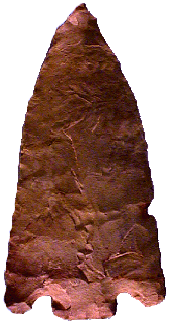
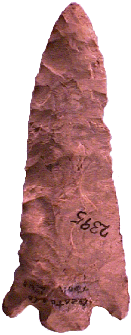
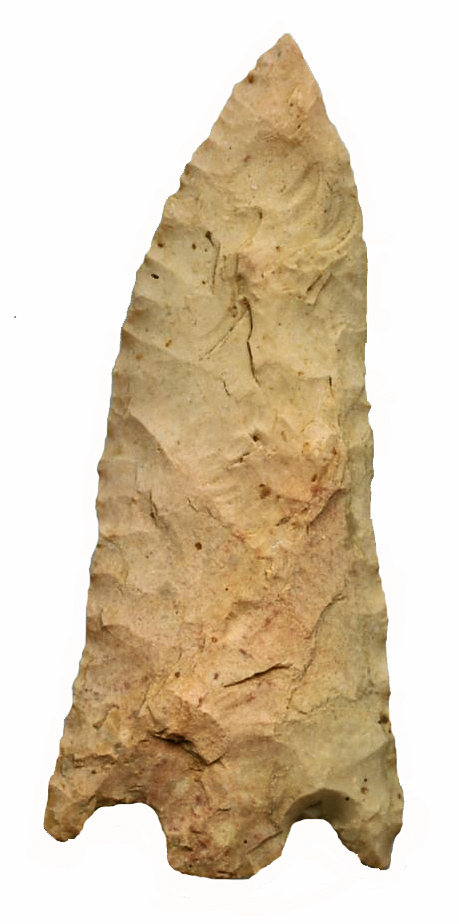
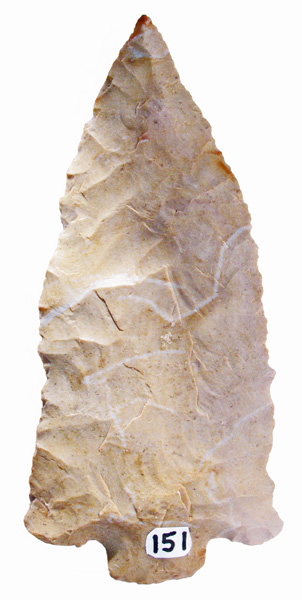
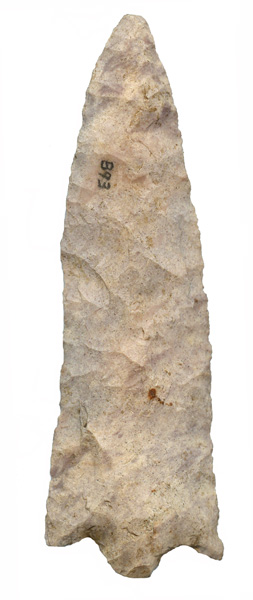





Point Type: EVA
Also See: Citrus, Culbreath, Hamilton Stemmed,
Hernando, Mehlville
, Milford, Parowan, San Saba, Shuma, Smith Basal Notched, Wade
Location: West Tennessee to Southwest Kentucky & Northern Alabama
Associated Dates:
8000 - 5000 B.P. - Early Archaic to Mid-Archaic
Morphology: Basal
Notched
General Description: The Eva point is a medium to large sized triangular Early Archaic dart or spear point with shallow basal notches, recurved sides and sometimes flaring tangs or barbs. There are two types within the Eva family, the Eva I and the Eva II. The type family was named by Madeline Kneberg Lewis in 1947 after the Eva excavation site in Benton County, Tennessee.
The earlier Eva I form has a long clearly defined straight or contracting short stem which may be equal in length or longer than the barbs. On the latter Eva II type, the barbs may extend below the base of the stem, and the stem is diminished in size and is rounded and contracting and is rarely ground. The Eva's barbs vary from squared, which show the corner of the preform blank, to pointed, and on the Eva II specimens the barbs may even be longer than the stem. The notches oftentimes show circular hertzian cone flake scars at the terminus of the notch. The notch is then often retouched with finer pressure flaking scars. Early examples can show parallel flaking scars. The stem on the Eva is rather small on both types, considering the overall blade dimensions. All edges of the stem on the Eva I type are basically straight and the basal edge is usually thinned and can be occasionally ground. On the Eva II type the stem is smaller, and contracting or rounded in outline. The blade shape on both types is biconvex or almost flat in cross section.
The Eva
point appears
to have a localized distribution only within the Tennessee Valley and in
fact Kneberg reported in 1956 that the Eva is seldom found outside the western half
of Tennessee. Some Eva points have been found in northern Alabama and Mississippi however,
(Little Bear Creek site (Webb & DeJarnette 1948)) Long and Josselyn
(1965:143) suggested an evolution from the Eva to the Morrow Mountain series.
Additionally, a rare type called the Ohio Basal Notched appears to be similar to
the Eva, and is reported by Waldorf (1987:137). However, DeRegnaucourt
reports a wider distribution covering all of Tennessee, northern
Alabama, Mississippi and Georgia, all of Kentucky and southern Indiana and southern Ohio
chiefly along the Ohio River Valley. Eva points have also been found in
central Ohio and Indiana but are rare in these two areas.
Many Eva
specimens were made from pink and tan cherts. The Smith Basal Notched
point type described by Baerreis and Freeman, Perino and Carl Chapman as well as
the Basal Notched Point is apparently the same point as the
Eva type. Many of the points exhibit a snap
fracture on the base which suggests that the point could have
been broken by thrusting or twisting. This would indicate the Eva's use as
a projectile tip. Some Eva points are also reworked from
what appears to be many times resulting in
their final stage use as drills. This would indicate
that the Eva may have started as a knife blade,
then a projectile point and ultimately as a drill, perforator or burin.
The Eva ranges in size from 40 mm to 120 mm in length with the typical average size being 61 mm. The width ranges from 25 mm to 47 mm with the average being 33 mm. The stem width ranges from 11 mm to 26 mm wide with the average being 18 mm. The stem length ranges from 5 mm to 8 mm with the average being 6 mm. The overall thickness ranges from 8 mm to 10 mm with the average being 9 mm.
About the Point Above (Left): The point pictured above on the left hand side of the page is a large Eva I point made from a dull brown chert. The point measures 84 mm in length, 42 mm at the widest point (across the tangs) and is uniformly 9 mm thick (which seems thin for its size). The stem is 17 mm wide. The base straight and is not ground. The notches are 8 mm long as is the stem. The flaking is parallel and there is very fine bifacial edge retouch along both blades. As you can clearly see, there is a chip on the right blade edge. This point is from Benton County, Tennessee. Catalog Number 56-65-D
About the Point Above (Center
Left): The
point pictured above on the center left hand side of the page is a large Eva
I point made from a dull light brown chert. The point measures 87
mm in length, 33 mm at the widest point (across the tangs) and is
9 mm thick at mid blade just above the notches. The stem is 8 mm
long, 14 mm wide and thins down to 4mm in thickness. The basal
edge is slightly ground. The flaking is parallel and there is
very fine bifacial edge retouch along both blades. As you can
clearly see, there is a chip on the right blade edge and the left
blade edge is highly reworked. This point is from Benton County,
Tennessee. Catalog Number 76-50-D
About the Point Above (Center): The point
pictured above on the center of the page is a large Eva I point
made
from a dull light brown Fort Payne chert. The point measures 73 mm in length, 31 mm at the
widest point (across the tangs) and is 9 mm thick at
mid blade just above the notches. The stem is 7 mm long, 12 mm wide
and thins down to 4mm in thickness. The basal edge is slightly ground. The flaking is
parallel with a few oblique transverse flakes. There is very fine bifacial edge retouch along both blade
edges. As you can clearly see, rework to the blade
has resulted in the left side being more convex than the
right side of the blade edge. Additionally the right tang has a
minor edge ding apparently sustained in historic times as it is patinated. This point
was found in Tishomingo County, Mississippi and was once in the E.C. Curtis
collection, the Tully collection and the Gary Noel Collection. The point has a
Jeff Baker certificate of Authentication, No.
10074 Catalog
Number 270-75-T
About the Point Above (Center
Right): The point
pictured above on the center right hand side of the page is a large
Eva I point made from a dull light tan chert which has some white veins running
through the blade. The point measures 84 mm in length, 38 mm at the widest
point (across the tangs) and the blade is 6.3 mm thick (which seems
thin for its size) with the thickest part being 8.6 mm just above the number tag
at the base. The stem is 15 mm wide. The base is straight and is smoothed. The
notches are 6.6 mm long as is the stem. The flaking is parallel and there
is very fine bifacial edge retouch along both blades giving the impression of
serrations. This point is from Benton County, Tennessee.
Catalog Number
151-45-D
About the Point Above (Far
Right): The point pictured above on the far
right hand side of the page is a very large Eva I point made from a dull
light tan chert which has some white veins running through the blade and
gray inclusions near the tip. The point measures 90 mm in length, 33 mm at the
widest point (across the tangs) and the blade is 7.4 mm thick with the thickest part
being 8.7 mm just above the number tag at the base. The
stem is 12.7mm wide and is of the rounded variant
type. The base is rounded and is smoothed. The notches are 4.6 mm long as is the stem. The flaking
is random and there is very fine bifacial edge retouch along both blades.
The point has a former inventory number penned in black ink as B93.
This point is from Benton County, Tennessee. The point has a Gregory Perino Artifact
Authentication Certificate and is was formerly in the Richard Nickel collection and the Chris Simonds
collection. Catalog
Number 370-65-D
About the Point Below
(Left):
The point pictured below on the left hand side of the page is a large Eva
I point made from a glossy light tan flint. The point measures 67
mm in length, 42 mm at the widest point (across the tangs) and is
7.5 mm thick at mid blade just above the notches. The stem has
been snapped off probably by misuse in prehistoric times. I am
not aware of a snapped base variant of the Eva type. There is
very fine bifacial edge retouch along both blade edges, however
the left side blade edge seems to have undergone more
resharpening than the left as evidenced by the reduced tang size.
This point is was found near Ramar, Tennessee. Catalog
Number
81-22-D
About the
Point Below (Center Left): The point pictured below in the center
left of the page
is a large Eva I point made from a dull, light tanish red-orange
colored Camden chert. The point measures 64 mm in length, 25 mm at the
widest point (across the tangs) and is 7.6 mm thick at mid blade just above the
notches. The stem has been snapped off probably by misuse in prehistoric times.
I am not aware of a snapped base variant of the Eva type. There is very fine
bifacial edge retouch along both blade edges, however the right side blade
edge seems to have undergone more resharpening than the left side. This
point is was found at the Eva site in Benton County, Tennessee.
This point was formerly in the E. C. Curtis, Gary Noel, Terry
Barker and Will Burkette collections. Catalog Number 335-73-HH
About
the Point Below (Center Right): The
point pictured below in the center right side of the page is
a large Eva I point made from a dull, light tanish red-orange
colored Camden chert. The point measures 55 mm in length, 31 mm
at the widest point (across the tangs) and is 8 mm thick at mid blade just
above the notches. The stem has been snapped off probably by misuse in
prehistoric times. I am not aware of a snapped base variant of the Eva type.
There is very fine bifacial edge retouch along both blade edges, however
the right side blade edge seems to have undergone more resharpening than
the left side especially near the tip. Additionally the left hand tang has
been chipped resulting in a shortened tang. This point is was found in
Lauderdale County, Alabama. Catalog
Number 474-33-AN
About the Point Below
(Right):
The point pictured below on
the right hand side of the page is an Eva I point made from a dull, dark gray mottled chert (probably Fort Payne) which has
some cream colored inclusions. The point measures 61 mm in length, 39 mm
at the widest point (across the tangs) and is 7.9 mm thick at mid blade just
above the notches. The stem is flat based and 17 mm wide. The blade has been
reworked extensivly especially on the left side of the blade. The left tang was spared from resharpening, possibly
due to being hafted. It extends furhter out beyond the current
profile of the blade. There is very fine bifacial edge retouch along
both blade edges, however the left side blade edge seems to have undergone
more resharpening than the right side. The point was found in
the western Tennessee river valley. Catalog
Number 369-18-D
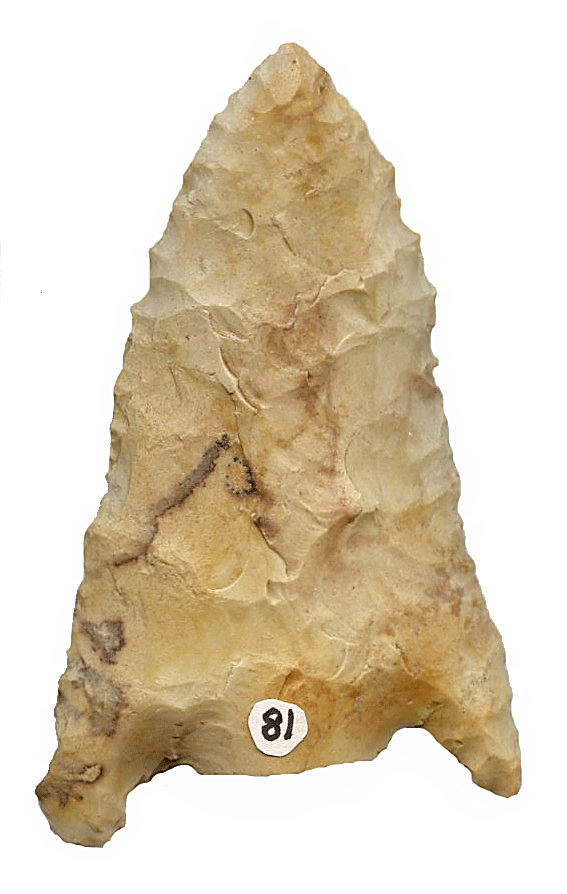
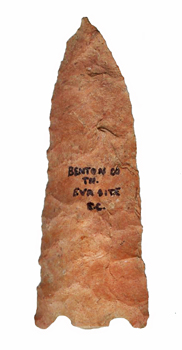
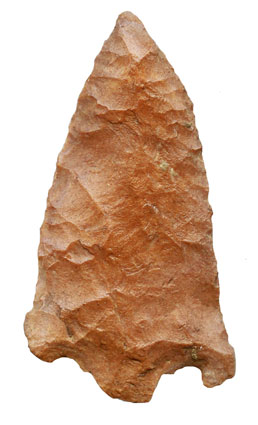
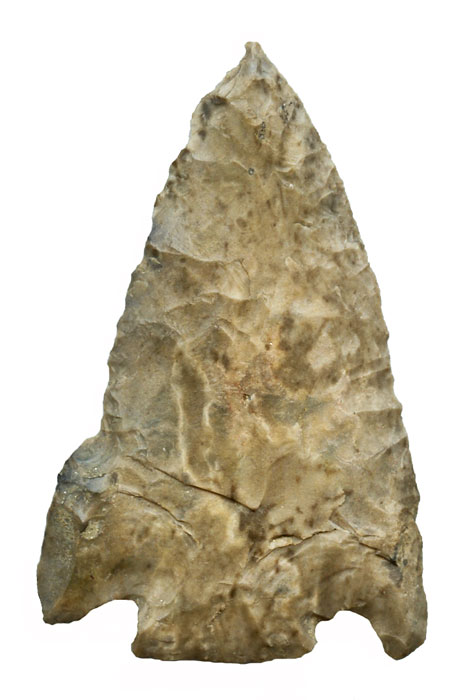
References: Baker, Bell (1), Cambron and Hulse, DeRegnaucourt, Dragoo (e), Hranicky (1), Justice (1), Overstreet, Perino (1), Puckett (1), Waldorf
© Copyright 1997 - 2009 LITHICS-Net WWW.LITHICSNET.COM
Use Your Browser's BACK Button to Return to the LITHICS-Net Index.